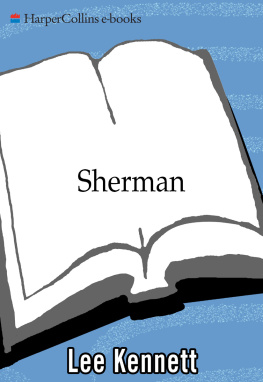TO THE READER
W illiam Tecumseh Sherman first came to the attention of the American public 140 years ago. Since then his has been an enduring presencenot a surprising fate for a man whom a whole generation of Americans was taught to look upon as either heroic or infamous. In todays population at large and among students of our most celebrated war there is a still a considerable range of opinion, some of it quite vehementin history, as in Shermans life, rarely could anyone be indifferent about the man.
My own interest in the general began as simple curiosity, stirred in the preparation of a previous work and encouraged by my editors at HarperCollins. As I progressed in research I found that conclusions about the man I had formed in the course of my earlier work had to be modifieda sign of fallibility, no doubt, but also, I hope, one of an essentially open mind.
The general once said, I must be judged as a soldier, and I have taken him at his word. The focus of this study, then, is Shermans military career; it accords well with my interest and work in military history over the past forty years. Necessarily, other aspects of the generals life can receive only limited coverage, but this choice too Sherman would have endorsed. His military career was central to his being; his marriage, his domestic and social lifeall else, in fact, had to be fitted in where the army left room.
With few exceptions I have forsaken traditional campaign history, the dissection of battles and the chronicling of campaigns; these matters merit books of their own, and in many cases have them. Then, more importantly, the man himself has claimed almost all the pages available, and I think rightly so.
From the day Sherman entered West Point until his retirement from the army forty-seven years later, virtually every aspect of his service life was documented in army records, and most of those records have survived; therefore this study rests to a considerable degree on quarrying done in the National Archives. For the period of the Civil War I have tried to go beyond archival materials printed in that vast compilation known to Civil War historians as the Official Records . To some extent I have succeeded, though my admiration for the compilers of the OR s has grown in the process. The generals twenty-three wartime letter books, lent to the government and never reclaimed by him, were a particularly rich source in the National Archives; so were the hundreds of orders he issued on the most varied subjects.
The treatment is in the main chronological, though I have paused here and there for closer looks at the nature of the man and his notions of waging war. The portrait presented here incorporates more somber hues than the reader may have encountered before. The man had his eccentricities, his not always laudable behavior patterns. These and the question of his supposed insanity seem to call for some sort of informed judgment on the generals psyche and its possible anomalies.
Finally I have concluded the book with a treatment of what might be called Shermans afterlife; what he contributed to the evolution of warfare and how his hero-villain image has fared over the last century, both in our nations history and in its folklore.
I n the half-decade it took for this work to progress from an idea to a bound volume I benefited at every turn from the advice and assistance of others. The initial proposal was framed with the help of Michael Condon, my literary agent, and Cynthia Barrett, who had edited an earlier book of mine at HarperCollins; subsequently I profited from the keen and incisive critique of my manuscript made by Paul McCarthy of HarperCollinss editorial department; subsequently Leslie Stern, Tim Duggan, and Kristen Schmidt ably guided the manuscript on through the editorial process. Thanks are also due to Eleanor Mikucki for her fine, thorough copyediting.
Much of the research for this work was done in Washington. At the National Archives, Michael Musick and Michael Meier directed me to the wealth of sources upon which this book largely rests. At the Library of Congress John Sellers shared his consummate knowledge of the Librarys manuscript collections.
I found able and helpful people at several repositories with large collections of Sherman materials. At West Point Suzanne Christoff and Allen Aimone of the United States Military Academy Library; at the Ohio Historical Society in Columbus, Gary J. Arnold and Tom House; at the U.S. Army Historical Research Center, Carlisle Barracks, Pennsylvania, John A. Slonaker, David Keough and Richard Sommers; at the Archives of the University of Notre Dame, Charles Lamb, Peter J. Lysy, and Marlene Wasikowsi.
I am also grateful for the help of persons in a number of other libraries and research institutions: Marjorie McNinch, at the Hagley Museum and Library, Wilmington, Delaware; Olga Tsapina, the Huntington Library; Connie Leitnaker, the Sherman House, Lancaster, Ohio; Henry G. Fulmer, South Caroliniana Library, Columbia; Lynn Hollingsworth, Kentucky Historical Society, Frankfort; Jill Costill and Stephen E. Towne, Indiana State Archives, Indianapolis; Terry Cook, California State Archives, Sacramento; Nicole Wells, New-York Historical Society; James J. Holmberg, the Filson Club Historical Society, Louisville; Diane B. Jacob, Archives of the Virginia Military Institute, Lexington; Brandon Sloane, Department of Military Affairs, Frankfort, Kentucky; Patricia Keats, California Historical Society, San Francisco; Ellen B. Thomasson, Missouri Historical Society, St. Louis; Patricia M. La Pointe, MemphisShelby County Library and Information Center; Sibille Zemitis, California State Library, Sacramento; Jennifer J. Bryan, Maryland Historical Society, Baltimore; Judy Bolton and Jo Jackson, LSU Libraries, Baton Rouge; William M. Fowler Jr., and Nicholas Graham, Massachusetts Historical Society, Boston; E. Lee Shepard, Virginia Historical Society, Richmond; Barbara E. Benson, Historical Society of Delaware, Wilmington; Joseph A. Horn, Boston Public Library; Pat Medert, Ross County Historical Association, Chillicothe, Ohio; and Edward Gaynor, Alderman Library, University of Virginia, Charlottesville.
Several fellow historians helped by directing me to Sherman materials, sharing with me items they had come upon or by reading portions of the manuscript and offering critiques: Fred Edmiston, Bill Kaan, Charles Wynes, Nash Boney, Archer Jones, and David Evans. Robert David Dawson was kind enough to share with me some of the countless Sherman letters he has tracked down and transcribed in archives all over the country.
I benefited from observations on Sherman by two men who shared with him the profession of arms: Lieutenant General Ormond Simpson, USMA (Ret.) and Colonel Charles Payne, United States Army. Dr. Walter Pharr looked over various texts and from them provided answers to a number of questions I had about Shermans health and final illness. Dr. Martha Simpson examined innumerable writings from the generals pen with the knowledge and insights of a psychologist. She guided me through the world of mental disorders and helped me find a meaningful pattern in the generals quirks and foibles, providing an answer to the charge of insanity that would dog him for the last thirty years of his life. Finally, Kendall Bennett and Michael Smith were of great assistance in preparing the final manuscript.











